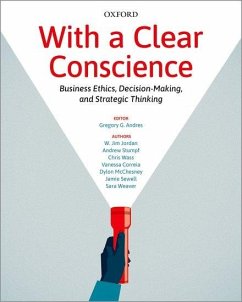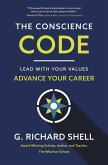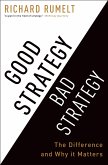W. Jim Jordan (PhD Candidate, Department of Philosophy, PhD Candida, Andrew Stumpf (Assistant Professor, Department of Philosophy, Assis, Chris Wass (PhD Student, Department of Philosophy, PhD Student, Dep
With a Clear Conscience
Business Ethics, Decision-Making, and Strategic Thinking
Herausgeber: Andres, Gregory G.
W. Jim Jordan (PhD Candidate, Department of Philosophy, PhD Candida, Andrew Stumpf (Assistant Professor, Department of Philosophy, Assis, Chris Wass (PhD Student, Department of Philosophy, PhD Student, Dep
With a Clear Conscience
Business Ethics, Decision-Making, and Strategic Thinking
Herausgeber: Andres, Gregory G.
- Broschiertes Buch
- Merkliste
- Auf die Merkliste
- Bewerten Bewerten
- Teilen
- Produkt teilen
- Produkterinnerung
- Produkterinnerung
Your current and practical guide to the ethical reasoning process in business.
Andere Kunden interessierten sich auch für
![The Conscience Code The Conscience Code]() G. Richard ShellThe Conscience Code23,99 €
G. Richard ShellThe Conscience Code23,99 €![Clear Leadership Clear Leadership]() Gervase BusheClear Leadership24,99 €
Gervase BusheClear Leadership24,99 €![Destination Conscience Destination Conscience]() Destination Conscience40,99 €
Destination Conscience40,99 €![Conscience With the Power and Cases Thereof Conscience With the Power and Cases Thereof]() William 1576-1633 AmesConscience With the Power and Cases Thereof31,99 €
William 1576-1633 AmesConscience With the Power and Cases Thereof31,99 €![Conscience With the Power and Cases Thereof Conscience With the Power and Cases Thereof]() William 1576-1633 AmesConscience With the Power and Cases Thereof44,99 €
William 1576-1633 AmesConscience With the Power and Cases Thereof44,99 €![Performance management work A Clear and Concise Reference Performance management work A Clear and Concise Reference]() Gerardus BlokdykPerformance management work A Clear and Concise Reference12,99 €
Gerardus BlokdykPerformance management work A Clear and Concise Reference12,99 €![Good Strategy Bad Strategy Good Strategy Bad Strategy]() Richard RumeltGood Strategy Bad Strategy16,99 €
Richard RumeltGood Strategy Bad Strategy16,99 €-
-
-
Your current and practical guide to the ethical reasoning process in business.
Hinweis: Dieser Artikel kann nur an eine deutsche Lieferadresse ausgeliefert werden.
Hinweis: Dieser Artikel kann nur an eine deutsche Lieferadresse ausgeliefert werden.
Produktdetails
- Produktdetails
- Verlag: Oxford University Press, Canada
- Seitenzahl: 304
- Erscheinungstermin: 31. Dezember 2020
- Englisch
- Abmessung: 205mm x 254mm x 16mm
- Gewicht: 578g
- ISBN-13: 9780199038398
- ISBN-10: 0199038392
- Artikelnr.: 60479951
- Herstellerkennzeichnung
- Libri GmbH
- Europaallee 1
- 36244 Bad Hersfeld
- 06621 890
- Verlag: Oxford University Press, Canada
- Seitenzahl: 304
- Erscheinungstermin: 31. Dezember 2020
- Englisch
- Abmessung: 205mm x 254mm x 16mm
- Gewicht: 578g
- ISBN-13: 9780199038398
- ISBN-10: 0199038392
- Artikelnr.: 60479951
- Herstellerkennzeichnung
- Libri GmbH
- Europaallee 1
- 36244 Bad Hersfeld
- 06621 890
Editor: Gregory G. Andres is a lecturer in the Department of Philosophy at the University of Waterloo. He is the course coordinator for business ethics and mentors first-time instructors who teach the course. Gregory also teaches critical thinking, logic, and game theory. He was recognized for his teaching at the University of Waterloo with the 2013 Arts Teaching Award. Authors: W. Jim Jordan is a PhD candidate in the Department of Philosophy at the University of Waterloo. His current research interests include cyberwarfare, international humanitarian law, formal philosophy in applied ethics, and philosophical pedagogy. Jim has worked for 15 years as a software designer and inventor at Nortel Networks and its predecessor companies. Andrew Stumpf is an assistant professor in Philosophy at St. Jerome's University in Waterloo. His research interests are wide-ranging but centred on ethics, with a particular focus on end-of-life issues. Andrew published a book on ancient philosophy (Ancient Philosophy: A Companion to the Core Readings, Broadview Press, 2018) and is currently working on an interdisciplinary project on the end-of-life-care that is funded by the Social Sciences and Humanities Research Council of Canada. Chris Wass is a PhD student in the Department of Philosophy at the University of Waterloo. His interests are in ethics, Marxism, and the philosophy of economics. Vanessa Correia is a faculty member at Conestoga College and a PhD candidate at the University of Waterloo. Her work focuses on business ethics, specifically how corporations can balance making profits with being socially responsible. Vanessa's research is funded by a Social Sciences and Humanities Research Council of Canada Doctoral Fellowship. Dylon McChesney is a PhD candidate in the Department of Philosophy at the University of Waterloo, where he has been teaching business ethics since 2015. His research interests include applied ethics in mental health issues and social cognition. Dylan's work in pedagogy involves designing and implementing games as teaching methods. Jamie Sewell is a PhD candidate in the Department of Philosophy at the University of Waterloo. Her current research takes an intersectional feminist and social epistemological approach to the legal standard of reasonableness. Jamie's philosophical approach is interdisciplinary, and she enjoys bringing philosophical tools and insights to students across all disciplines. Her research in critical pedagogy was funded by the Social Sciences and Humanities Research Council of Canada. Jamie has won several teaching awards. Sara Weaver is a graduate from the PhD program in the Department of Philosophy at the University of Waterloo. She is currently a senior research analyst for the Government of the Northwest Territories Department of Education, Culture and Employment. Sara was a recipient of the SSHRC Joseph Armand Bombardier Canadian Graduate Scholarship during her doctoral studies. Her research focused on ethical scientific practices and the use of experimental methods in philosophy. Sara has taught various courses in philosophy, including business ethics. She has numerous academic publications in the areas of psychology, experimental philosophy, and the philosophy of science.
List of Boxes and Case Studies
Preface
A Note to Instructors
From the Publisher
Introduction
What This Text is About
Features of This Book
Being an Ethical Disruptor
A Note on Game Theory and Philosophy
Our Challenge to the Reader
1: Business Ethics and Ethical Business
A Modest Approach to Ethics
Ethics is More Than Opinion
Ethical Relativism
In Support of Ethical Relativism
Problems with Ethical Relativism
A Middle Way: Humble Objectivism
Humble Objectivism and Ethical Pluralism
The Place of Ethics in Business
Why Should Businesspeople Want to Be Ethical?
The Social Context of Business Activity
The Social Responsibilities of Business
The Market-Failures Approach to Ethics
Everyday Norms and Business Norms
The Ten Commandments of Business Ethics
Summing Up
For Discussion and Review
Further Reading
2: Thinking in Ethical Terms
Deontological Ethics: Duty, Principles, and Rights
Kant's Categorical Imperative
Ross's Prima Facie Duties
Rights-Based Deontological Ethics
Utilitarianism
Virtue Ethics
Ethics of Care
The Capability Approach
Capabilities
Which Capabilities?
Summary of Ethical Theory
Living with Your Decisions: A Clear Conscience
Private and Public Domains
Accepting Moral Tragedy
The Light of Day and How to Sleep at Night
Summing Up
For Discussion and Review
Further Reading
3: Ethical DecisionMaking
Private and Public Morality Revisited
Ethical Pluralism Revisited
Moral Disagreements
Stakeholders: Whose Interests Matter?
Value Conflicts
Making Ethical Decisions
Moral Intuition versus Moral Reasoning
Bias and Decision Making
An Ethical Decision-Making Model
Step 1: Identify Relevant Facts
Step 2: Identify Relevant Stakeholders and Ethical Issues
Step 3: Identify Stakeholder Values and Conflicts
Step 4: Create Resolution Strategies and Identify Consequences
Step 5: Assess the Strategies
Step 6: Recommend and Defend a Resolution Strategy
The Payoff
Dirty Hands
Summing Up
For Discussion and Review
Further Reading
4: Corporate Social Responsibility
Profitability and Legality
Business as War
Strong Fiduciary Responsibility
Weak Fiduciary Responsibility
The Invisible Hand
Theories of Corporate Social Responsibility
Applying Stakeholder Theory: Triple Bottom Line
Pyramid of Corporate Responsibility
Three-Domain Model
An Argument for Corporate Social Responsibility
Summing Up
For Discussion and Review
Further Reading
5: Fairness and Non-Discrimination
Equal Opportunity as Fairness
Rawls on Justice as Fairness
The Harms of Injustice
Workplace Inequalities
Wage Gap
Implicit Bias and the Workplace
Tips to Control for Bias
Accommodation
Barriers to Access
Religious Accommodation
Sexual Harassment
Ethnocentric Harassment
Why Should I Care?
Personal Affect
Corporate Profit
Moral Obligation
Personal Protection
Resources
Canadian Charter of Rights and Freedoms
Canadian Human Rights Act
Canadian Human Rights Commission
Employment Equity Act (2010)
Federal and Provincial Accessibility Legislation
Occupational Health and Safety
International Labour Organization
Summing Up
For Discussion and Review
Further Reading
6: Social Action Problems
The Social Contract and Enlightened Self-Interest
Social Action Problems
The Prisoner's Dilemma
The Free-Rider Problem
Moral Hazard
The Game of Chicken
Social Action Problems in the Wild
Unhealthy Competition
The Principal-Agent Problem
Dirty Dishes
Pre-Emptive Strikes
"But They're Doing It!"
Trust, Coordination, and the Benefits of Co-Operation
Summing Up
For Discussion and Review
Further Reading
7: Environment, Ethics, and Business
The Value of Nature
Two Types of Value
Instrumental Value
Intrinsic Value
Whence Catastrophe?
Shared Study Space
Agriculture in Kansas
Reframing the Environmental Conversation
Light Green Approach
Market Green Approach
Stakeholder Green Approach
Dark Green Approach
Hybrid Strategies
Bargaining and the Coase Theorem
The Features of the Coase Theorem
Internalizing Externalities: An Application of the Coase Theorem
The Limits of the Coase Theorem
Climate Justice: Environmental Harm and Marginalized Peoples
Summing Up
For Discussion and Review
Further Reading
8: The Power of Advertising
Ethical Issues in Advertising
Canadian Advertising Regulations
Bypassing Rationality
Framing Information
Appealing to Emotion
Priming and Deception
How Advertising Harms
Gender Roles
Abuse
Racism
Body Image and Sexuality
Summing Up
For Discussion and Review
Further Reading
9: Corporate Governance and Perverse Incentives
Corporate Structure
Shareholders
Directors or Trustees
Officers and Executives
Managers and Working Staff
Principals and Agents
The Principal-Agent Relationship
Principal-Agent Problems
Perverse Incentives
Setting Up for a Fall
Dodging the Consequences
When All Else Fails
Summing Up
For Discussion and Review
Further Reading
10: Strategic Negotiations
Strategic Moves
Credibility
Making Strategic Moves
Resisting Strategic Moves
Strategic Sanctions
Strategic Moves and Social Action Problems
Acing the Exam Strategically
Inflationary Incentives
Heavy Lifting and Heavy Metal
Ethical Disputes
Positions and Interests
Types of Bargaining
Skills and Attitudes
Applying the Concepts
Social Media and Privacy
Summing Up
For Discussion and Review
Further Reading
11: Whistle-Blowing and Codes of Ethics
Professional Expectations and Codes of Ethics
Internal Reporting Mechanisms
Overcoming Internal Obstacles
How to Think about Whistle-Blowing
A Public Act
A Conflict between Public and Private Morality
A Matter of Public Duty
To Blow the Whistle or Not to Blow the Whistle?
What Are My Options?
Summing Up
For Discussion and Review
Further Reading
12: Concluding Thoughts
Pre-Market Ethics
Pro-Social Business
Strategic Co-Operation
From the Gallery into the World
For Discussion and Review
Appendix A: Ethical Decision-Making Model Worksheets
Appendix B: A Primer on Game Theory
Appendix C: Concept Check Answers
Notes
Glossary
Index
Preface
A Note to Instructors
From the Publisher
Introduction
What This Text is About
Features of This Book
Being an Ethical Disruptor
A Note on Game Theory and Philosophy
Our Challenge to the Reader
1: Business Ethics and Ethical Business
A Modest Approach to Ethics
Ethics is More Than Opinion
Ethical Relativism
In Support of Ethical Relativism
Problems with Ethical Relativism
A Middle Way: Humble Objectivism
Humble Objectivism and Ethical Pluralism
The Place of Ethics in Business
Why Should Businesspeople Want to Be Ethical?
The Social Context of Business Activity
The Social Responsibilities of Business
The Market-Failures Approach to Ethics
Everyday Norms and Business Norms
The Ten Commandments of Business Ethics
Summing Up
For Discussion and Review
Further Reading
2: Thinking in Ethical Terms
Deontological Ethics: Duty, Principles, and Rights
Kant's Categorical Imperative
Ross's Prima Facie Duties
Rights-Based Deontological Ethics
Utilitarianism
Virtue Ethics
Ethics of Care
The Capability Approach
Capabilities
Which Capabilities?
Summary of Ethical Theory
Living with Your Decisions: A Clear Conscience
Private and Public Domains
Accepting Moral Tragedy
The Light of Day and How to Sleep at Night
Summing Up
For Discussion and Review
Further Reading
3: Ethical DecisionMaking
Private and Public Morality Revisited
Ethical Pluralism Revisited
Moral Disagreements
Stakeholders: Whose Interests Matter?
Value Conflicts
Making Ethical Decisions
Moral Intuition versus Moral Reasoning
Bias and Decision Making
An Ethical Decision-Making Model
Step 1: Identify Relevant Facts
Step 2: Identify Relevant Stakeholders and Ethical Issues
Step 3: Identify Stakeholder Values and Conflicts
Step 4: Create Resolution Strategies and Identify Consequences
Step 5: Assess the Strategies
Step 6: Recommend and Defend a Resolution Strategy
The Payoff
Dirty Hands
Summing Up
For Discussion and Review
Further Reading
4: Corporate Social Responsibility
Profitability and Legality
Business as War
Strong Fiduciary Responsibility
Weak Fiduciary Responsibility
The Invisible Hand
Theories of Corporate Social Responsibility
Applying Stakeholder Theory: Triple Bottom Line
Pyramid of Corporate Responsibility
Three-Domain Model
An Argument for Corporate Social Responsibility
Summing Up
For Discussion and Review
Further Reading
5: Fairness and Non-Discrimination
Equal Opportunity as Fairness
Rawls on Justice as Fairness
The Harms of Injustice
Workplace Inequalities
Wage Gap
Implicit Bias and the Workplace
Tips to Control for Bias
Accommodation
Barriers to Access
Religious Accommodation
Sexual Harassment
Ethnocentric Harassment
Why Should I Care?
Personal Affect
Corporate Profit
Moral Obligation
Personal Protection
Resources
Canadian Charter of Rights and Freedoms
Canadian Human Rights Act
Canadian Human Rights Commission
Employment Equity Act (2010)
Federal and Provincial Accessibility Legislation
Occupational Health and Safety
International Labour Organization
Summing Up
For Discussion and Review
Further Reading
6: Social Action Problems
The Social Contract and Enlightened Self-Interest
Social Action Problems
The Prisoner's Dilemma
The Free-Rider Problem
Moral Hazard
The Game of Chicken
Social Action Problems in the Wild
Unhealthy Competition
The Principal-Agent Problem
Dirty Dishes
Pre-Emptive Strikes
"But They're Doing It!"
Trust, Coordination, and the Benefits of Co-Operation
Summing Up
For Discussion and Review
Further Reading
7: Environment, Ethics, and Business
The Value of Nature
Two Types of Value
Instrumental Value
Intrinsic Value
Whence Catastrophe?
Shared Study Space
Agriculture in Kansas
Reframing the Environmental Conversation
Light Green Approach
Market Green Approach
Stakeholder Green Approach
Dark Green Approach
Hybrid Strategies
Bargaining and the Coase Theorem
The Features of the Coase Theorem
Internalizing Externalities: An Application of the Coase Theorem
The Limits of the Coase Theorem
Climate Justice: Environmental Harm and Marginalized Peoples
Summing Up
For Discussion and Review
Further Reading
8: The Power of Advertising
Ethical Issues in Advertising
Canadian Advertising Regulations
Bypassing Rationality
Framing Information
Appealing to Emotion
Priming and Deception
How Advertising Harms
Gender Roles
Abuse
Racism
Body Image and Sexuality
Summing Up
For Discussion and Review
Further Reading
9: Corporate Governance and Perverse Incentives
Corporate Structure
Shareholders
Directors or Trustees
Officers and Executives
Managers and Working Staff
Principals and Agents
The Principal-Agent Relationship
Principal-Agent Problems
Perverse Incentives
Setting Up for a Fall
Dodging the Consequences
When All Else Fails
Summing Up
For Discussion and Review
Further Reading
10: Strategic Negotiations
Strategic Moves
Credibility
Making Strategic Moves
Resisting Strategic Moves
Strategic Sanctions
Strategic Moves and Social Action Problems
Acing the Exam Strategically
Inflationary Incentives
Heavy Lifting and Heavy Metal
Ethical Disputes
Positions and Interests
Types of Bargaining
Skills and Attitudes
Applying the Concepts
Social Media and Privacy
Summing Up
For Discussion and Review
Further Reading
11: Whistle-Blowing and Codes of Ethics
Professional Expectations and Codes of Ethics
Internal Reporting Mechanisms
Overcoming Internal Obstacles
How to Think about Whistle-Blowing
A Public Act
A Conflict between Public and Private Morality
A Matter of Public Duty
To Blow the Whistle or Not to Blow the Whistle?
What Are My Options?
Summing Up
For Discussion and Review
Further Reading
12: Concluding Thoughts
Pre-Market Ethics
Pro-Social Business
Strategic Co-Operation
From the Gallery into the World
For Discussion and Review
Appendix A: Ethical Decision-Making Model Worksheets
Appendix B: A Primer on Game Theory
Appendix C: Concept Check Answers
Notes
Glossary
Index
List of Boxes and Case Studies
Preface
A Note to Instructors
From the Publisher
Introduction
What This Text is About
Features of This Book
Being an Ethical Disruptor
A Note on Game Theory and Philosophy
Our Challenge to the Reader
1: Business Ethics and Ethical Business
A Modest Approach to Ethics
Ethics is More Than Opinion
Ethical Relativism
In Support of Ethical Relativism
Problems with Ethical Relativism
A Middle Way: Humble Objectivism
Humble Objectivism and Ethical Pluralism
The Place of Ethics in Business
Why Should Businesspeople Want to Be Ethical?
The Social Context of Business Activity
The Social Responsibilities of Business
The Market-Failures Approach to Ethics
Everyday Norms and Business Norms
The Ten Commandments of Business Ethics
Summing Up
For Discussion and Review
Further Reading
2: Thinking in Ethical Terms
Deontological Ethics: Duty, Principles, and Rights
Kant's Categorical Imperative
Ross's Prima Facie Duties
Rights-Based Deontological Ethics
Utilitarianism
Virtue Ethics
Ethics of Care
The Capability Approach
Capabilities
Which Capabilities?
Summary of Ethical Theory
Living with Your Decisions: A Clear Conscience
Private and Public Domains
Accepting Moral Tragedy
The Light of Day and How to Sleep at Night
Summing Up
For Discussion and Review
Further Reading
3: Ethical DecisionMaking
Private and Public Morality Revisited
Ethical Pluralism Revisited
Moral Disagreements
Stakeholders: Whose Interests Matter?
Value Conflicts
Making Ethical Decisions
Moral Intuition versus Moral Reasoning
Bias and Decision Making
An Ethical Decision-Making Model
Step 1: Identify Relevant Facts
Step 2: Identify Relevant Stakeholders and Ethical Issues
Step 3: Identify Stakeholder Values and Conflicts
Step 4: Create Resolution Strategies and Identify Consequences
Step 5: Assess the Strategies
Step 6: Recommend and Defend a Resolution Strategy
The Payoff
Dirty Hands
Summing Up
For Discussion and Review
Further Reading
4: Corporate Social Responsibility
Profitability and Legality
Business as War
Strong Fiduciary Responsibility
Weak Fiduciary Responsibility
The Invisible Hand
Theories of Corporate Social Responsibility
Applying Stakeholder Theory: Triple Bottom Line
Pyramid of Corporate Responsibility
Three-Domain Model
An Argument for Corporate Social Responsibility
Summing Up
For Discussion and Review
Further Reading
5: Fairness and Non-Discrimination
Equal Opportunity as Fairness
Rawls on Justice as Fairness
The Harms of Injustice
Workplace Inequalities
Wage Gap
Implicit Bias and the Workplace
Tips to Control for Bias
Accommodation
Barriers to Access
Religious Accommodation
Sexual Harassment
Ethnocentric Harassment
Why Should I Care?
Personal Affect
Corporate Profit
Moral Obligation
Personal Protection
Resources
Canadian Charter of Rights and Freedoms
Canadian Human Rights Act
Canadian Human Rights Commission
Employment Equity Act (2010)
Federal and Provincial Accessibility Legislation
Occupational Health and Safety
International Labour Organization
Summing Up
For Discussion and Review
Further Reading
6: Social Action Problems
The Social Contract and Enlightened Self-Interest
Social Action Problems
The Prisoner's Dilemma
The Free-Rider Problem
Moral Hazard
The Game of Chicken
Social Action Problems in the Wild
Unhealthy Competition
The Principal-Agent Problem
Dirty Dishes
Pre-Emptive Strikes
"But They're Doing It!"
Trust, Coordination, and the Benefits of Co-Operation
Summing Up
For Discussion and Review
Further Reading
7: Environment, Ethics, and Business
The Value of Nature
Two Types of Value
Instrumental Value
Intrinsic Value
Whence Catastrophe?
Shared Study Space
Agriculture in Kansas
Reframing the Environmental Conversation
Light Green Approach
Market Green Approach
Stakeholder Green Approach
Dark Green Approach
Hybrid Strategies
Bargaining and the Coase Theorem
The Features of the Coase Theorem
Internalizing Externalities: An Application of the Coase Theorem
The Limits of the Coase Theorem
Climate Justice: Environmental Harm and Marginalized Peoples
Summing Up
For Discussion and Review
Further Reading
8: The Power of Advertising
Ethical Issues in Advertising
Canadian Advertising Regulations
Bypassing Rationality
Framing Information
Appealing to Emotion
Priming and Deception
How Advertising Harms
Gender Roles
Abuse
Racism
Body Image and Sexuality
Summing Up
For Discussion and Review
Further Reading
9: Corporate Governance and Perverse Incentives
Corporate Structure
Shareholders
Directors or Trustees
Officers and Executives
Managers and Working Staff
Principals and Agents
The Principal-Agent Relationship
Principal-Agent Problems
Perverse Incentives
Setting Up for a Fall
Dodging the Consequences
When All Else Fails
Summing Up
For Discussion and Review
Further Reading
10: Strategic Negotiations
Strategic Moves
Credibility
Making Strategic Moves
Resisting Strategic Moves
Strategic Sanctions
Strategic Moves and Social Action Problems
Acing the Exam Strategically
Inflationary Incentives
Heavy Lifting and Heavy Metal
Ethical Disputes
Positions and Interests
Types of Bargaining
Skills and Attitudes
Applying the Concepts
Social Media and Privacy
Summing Up
For Discussion and Review
Further Reading
11: Whistle-Blowing and Codes of Ethics
Professional Expectations and Codes of Ethics
Internal Reporting Mechanisms
Overcoming Internal Obstacles
How to Think about Whistle-Blowing
A Public Act
A Conflict between Public and Private Morality
A Matter of Public Duty
To Blow the Whistle or Not to Blow the Whistle?
What Are My Options?
Summing Up
For Discussion and Review
Further Reading
12: Concluding Thoughts
Pre-Market Ethics
Pro-Social Business
Strategic Co-Operation
From the Gallery into the World
For Discussion and Review
Appendix A: Ethical Decision-Making Model Worksheets
Appendix B: A Primer on Game Theory
Appendix C: Concept Check Answers
Notes
Glossary
Index
Preface
A Note to Instructors
From the Publisher
Introduction
What This Text is About
Features of This Book
Being an Ethical Disruptor
A Note on Game Theory and Philosophy
Our Challenge to the Reader
1: Business Ethics and Ethical Business
A Modest Approach to Ethics
Ethics is More Than Opinion
Ethical Relativism
In Support of Ethical Relativism
Problems with Ethical Relativism
A Middle Way: Humble Objectivism
Humble Objectivism and Ethical Pluralism
The Place of Ethics in Business
Why Should Businesspeople Want to Be Ethical?
The Social Context of Business Activity
The Social Responsibilities of Business
The Market-Failures Approach to Ethics
Everyday Norms and Business Norms
The Ten Commandments of Business Ethics
Summing Up
For Discussion and Review
Further Reading
2: Thinking in Ethical Terms
Deontological Ethics: Duty, Principles, and Rights
Kant's Categorical Imperative
Ross's Prima Facie Duties
Rights-Based Deontological Ethics
Utilitarianism
Virtue Ethics
Ethics of Care
The Capability Approach
Capabilities
Which Capabilities?
Summary of Ethical Theory
Living with Your Decisions: A Clear Conscience
Private and Public Domains
Accepting Moral Tragedy
The Light of Day and How to Sleep at Night
Summing Up
For Discussion and Review
Further Reading
3: Ethical DecisionMaking
Private and Public Morality Revisited
Ethical Pluralism Revisited
Moral Disagreements
Stakeholders: Whose Interests Matter?
Value Conflicts
Making Ethical Decisions
Moral Intuition versus Moral Reasoning
Bias and Decision Making
An Ethical Decision-Making Model
Step 1: Identify Relevant Facts
Step 2: Identify Relevant Stakeholders and Ethical Issues
Step 3: Identify Stakeholder Values and Conflicts
Step 4: Create Resolution Strategies and Identify Consequences
Step 5: Assess the Strategies
Step 6: Recommend and Defend a Resolution Strategy
The Payoff
Dirty Hands
Summing Up
For Discussion and Review
Further Reading
4: Corporate Social Responsibility
Profitability and Legality
Business as War
Strong Fiduciary Responsibility
Weak Fiduciary Responsibility
The Invisible Hand
Theories of Corporate Social Responsibility
Applying Stakeholder Theory: Triple Bottom Line
Pyramid of Corporate Responsibility
Three-Domain Model
An Argument for Corporate Social Responsibility
Summing Up
For Discussion and Review
Further Reading
5: Fairness and Non-Discrimination
Equal Opportunity as Fairness
Rawls on Justice as Fairness
The Harms of Injustice
Workplace Inequalities
Wage Gap
Implicit Bias and the Workplace
Tips to Control for Bias
Accommodation
Barriers to Access
Religious Accommodation
Sexual Harassment
Ethnocentric Harassment
Why Should I Care?
Personal Affect
Corporate Profit
Moral Obligation
Personal Protection
Resources
Canadian Charter of Rights and Freedoms
Canadian Human Rights Act
Canadian Human Rights Commission
Employment Equity Act (2010)
Federal and Provincial Accessibility Legislation
Occupational Health and Safety
International Labour Organization
Summing Up
For Discussion and Review
Further Reading
6: Social Action Problems
The Social Contract and Enlightened Self-Interest
Social Action Problems
The Prisoner's Dilemma
The Free-Rider Problem
Moral Hazard
The Game of Chicken
Social Action Problems in the Wild
Unhealthy Competition
The Principal-Agent Problem
Dirty Dishes
Pre-Emptive Strikes
"But They're Doing It!"
Trust, Coordination, and the Benefits of Co-Operation
Summing Up
For Discussion and Review
Further Reading
7: Environment, Ethics, and Business
The Value of Nature
Two Types of Value
Instrumental Value
Intrinsic Value
Whence Catastrophe?
Shared Study Space
Agriculture in Kansas
Reframing the Environmental Conversation
Light Green Approach
Market Green Approach
Stakeholder Green Approach
Dark Green Approach
Hybrid Strategies
Bargaining and the Coase Theorem
The Features of the Coase Theorem
Internalizing Externalities: An Application of the Coase Theorem
The Limits of the Coase Theorem
Climate Justice: Environmental Harm and Marginalized Peoples
Summing Up
For Discussion and Review
Further Reading
8: The Power of Advertising
Ethical Issues in Advertising
Canadian Advertising Regulations
Bypassing Rationality
Framing Information
Appealing to Emotion
Priming and Deception
How Advertising Harms
Gender Roles
Abuse
Racism
Body Image and Sexuality
Summing Up
For Discussion and Review
Further Reading
9: Corporate Governance and Perverse Incentives
Corporate Structure
Shareholders
Directors or Trustees
Officers and Executives
Managers and Working Staff
Principals and Agents
The Principal-Agent Relationship
Principal-Agent Problems
Perverse Incentives
Setting Up for a Fall
Dodging the Consequences
When All Else Fails
Summing Up
For Discussion and Review
Further Reading
10: Strategic Negotiations
Strategic Moves
Credibility
Making Strategic Moves
Resisting Strategic Moves
Strategic Sanctions
Strategic Moves and Social Action Problems
Acing the Exam Strategically
Inflationary Incentives
Heavy Lifting and Heavy Metal
Ethical Disputes
Positions and Interests
Types of Bargaining
Skills and Attitudes
Applying the Concepts
Social Media and Privacy
Summing Up
For Discussion and Review
Further Reading
11: Whistle-Blowing and Codes of Ethics
Professional Expectations and Codes of Ethics
Internal Reporting Mechanisms
Overcoming Internal Obstacles
How to Think about Whistle-Blowing
A Public Act
A Conflict between Public and Private Morality
A Matter of Public Duty
To Blow the Whistle or Not to Blow the Whistle?
What Are My Options?
Summing Up
For Discussion and Review
Further Reading
12: Concluding Thoughts
Pre-Market Ethics
Pro-Social Business
Strategic Co-Operation
From the Gallery into the World
For Discussion and Review
Appendix A: Ethical Decision-Making Model Worksheets
Appendix B: A Primer on Game Theory
Appendix C: Concept Check Answers
Notes
Glossary
Index








